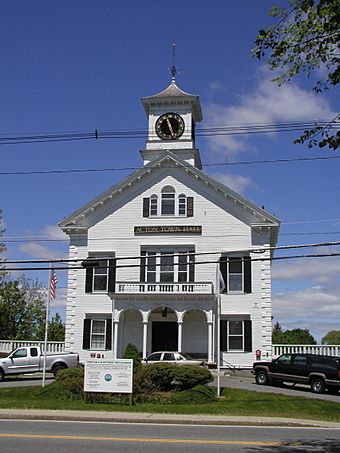Acton Centre Historic District facts for kids
Quick facts for kids |
|
|
Acton Centre Historic District
|
|
 |
|
| Location | Main St., Wood and Woodbur Lanes, Newton, Concord, and Nagog Hill Rds. Acton, Massachusetts |
|---|---|
| Area | 33.5 acres (13.6 ha) |
| Architect | Hartwell and Richardson; Taylor, Moses |
| Architectural style | Greek Revival, Federal |
| NRHP reference No. | 83000780 |
| Added to NRHP | March 10, 1983 |
The Acton Centre Historic District is like the old downtown of Acton, Massachusetts. It's a special area that shows how the town grew over hundreds of years. This district includes many historic buildings along Main Street and other nearby roads. It has been the main gathering place for the town since the 1730s. In 1983, it was added to the National Register of Historic Places. This means it's recognized as an important historical site in the United States.
Contents
Discovering Acton Centre's Past
The Acton Centre Historic District is a fascinating place. It tells the story of how Acton, Massachusetts, began and grew. This area was once a quiet farming community. Today, it's a busy suburban town.
How Acton Centre Began
The land that became Acton was first given to English settlers in 1643. However, people didn't start living there until 1680. Back then, it was part of a larger town called Concord. Acton officially became its own town in 1735. This is called being "incorporated."
The first town buildings and a common area were built in the center of Acton. For many years, it stayed a small farming village. Other parts of Acton, like West Acton and South Acton, grew faster. This was because they had water power for factories. Acton Centre also didn't get a railroad line.
However, Acton Centre remained important. It was home to the town's churches and government buildings. This made it the heart of the community.
Architecture in Acton Centre
Many of the old houses in Acton Centre have special styles.
- Federal style: These houses were built in the late 1700s and early 1800s. They often look grand and balanced.
- Greek Revival style: Popular in the early to mid-1800s, these homes look like ancient Greek temples. They often have tall columns.
You can also find some houses with later styles:
- Italianate: These homes often have low-pitched roofs and decorative brackets.
- Queen Anne: Built in the late 1800s, these houses are known for their towers, turrets, and varied textures.
- Colonial Revival: These homes were built in the early 1900s. They copied the look of older colonial houses.
Key Locations in the District
The historic district stretches along Main Street. This road is also known as Massachusetts Route 27. It goes from a common area in the west to Nagog Hill in the east. A few buildings on nearby streets are also part of the district.
The Town Common
The common is a triangular park. It's what's left of the town's original common, created in 1731. This common is very important to American history. It has a monument to the American Revolutionary War. This is where Acton's local soldiers gathered. They marched from here to fight in the Battles of Lexington and Concord. These battles helped start the Revolutionary War.
Important Public Buildings
Several key town buildings are located in the district:
- Congregational Church: Built in 1846, this church was later updated with Queen Anne style details.
- Town Hall: Constructed in 1863, the Town Hall shows the Italianate style. It's where town meetings and government work happen.
- Acton Memorial Library: This beautiful library was built in 1889. It features the Romanesque Revival style. This style often uses round arches and sturdy stone.



